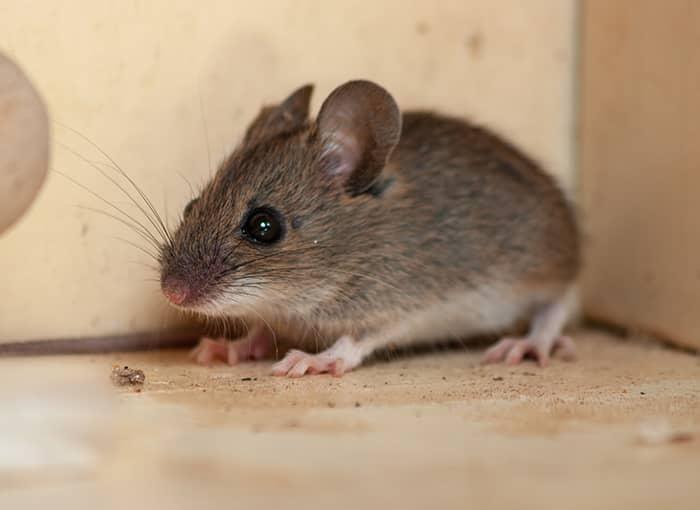Mice scuttle around Upper School
Community recounts sightings of rodent rascals
March 2, 2022
When a mouse scampered across the floor of room 273 at 10:25 a.m. on February 8, Alexandra Fabbri ’23 let out a screech. Then, she whipped out her phone to record the mouse. This would be the first of many mice sightings for her, and the first of three classes to be reported to be disrupted by a rodent.
Alexandra said seeing a mouse was startling at first but that she eventually found humor in the situation.
“I was just really amused,” Alexandra said. “My classmates found it really funny that while they were all trying to back away and literally hopping onto their desks to avoid the little tiny mouse on the ground, I was going to walk toward it with my camera.”
Accounts of nibbled books and mice droppings began in late January, while actual sightings of the animals spread around the school during the beginning of February. Upper School (US) Facilities Team Member Diane Cannata said there have been at least 10 separate reports, an unprecedented amount, mainly occurring in the old wing of the school past The Vanguard office.
US History and Social Sciences Teacher Farah DiPasquale reported a bag of chips shredded and eaten by mice weeks before the
sighting in room 273. Then, she noticed eaten candy in US History and Social Sciences Teacher Matt Turnbull’s Darth Vader helmet. After that, she began looking for evidence each morning and asked Ms. Cannata to bring traps. Though the issue has been handled well, Ms. DiPasquale said, it did cause some distrubances.
“I became distracted, and I wasted an entire free period,” Ms. DiPasquale said. “I Clorox wiped all my surfaces, and honestly I Googled information on the kinds of diseases humans can contract from mice and was relieved to find that prospect to be unlikely.”
Facilities placed 20 traps around areas of known infestation in the school and filled holes in the walls to prevent mice from entering classrooms and offices. While these methods help, Ms. Cannata said, they don’t completely resolve the issue.
“We don’t really catch a lot in the traps,” she said. “I’ve been spending way too much time dealing with it lately, and there are faculty members who are upset by it.”
Ms. Cannata said this issue may be the result of open doors and windows during the 2020-2021 school year. While the mice problem has seemingly improved over the last weeks, Ms. Cannata said, she still has concerns about the health and safety issues the rodents bring to the school.
“As you can see in Alexandra’s video, the mouse disrupts the classroom. People are up on their chairs; the teacher had their feet up in the air,” she said. “We don’t want them eating or getting into food and books. They’re vermin—the same category as rats, cockroaches, lice, bedbugs, and flies. Outside, they’re fine. We don’t want them inside.”
On the week of February 14, Avery Hart ’25 saw a mouse in her history class in room 283, which, she said, was distracting to her class.
“There was a lot of talking over each other after, and my teacher wasn’t able to settle us down and get our full attention for many minutes,” she said. “It was very chaotic.”
Sofia Khoury ’23 saw a mouse in her history class in room 283 on February 8 and noticed a period of disruption in response to its coming out of the radiator, she said.
“Some people were laughing and naming the mouse,” she said. “Mr. Turnbull had to tell us twice, ‘Guys, we’re doing our history research papers, let’s be on task.’”
Mr. Turnbull said the mouse “caused a bit of a stir” before students settled down but said he didn’t mind the short interruption.
“We don’t really want mice running around the classroom, but sometimes things like that create a common experience, and that is not such a bad thing,” he said. “Mice are part of our world, and they get into our places. It’s one of those things that people get uncomfortable about, but actually, we can deal with the problem.”
While students and teachers don’t foresee a mice invasion, they have various opinions on how the problem should be handled. Neel Scherfke ’23 said a few mice sightings isn’t a large concern but more extreme measures may need to be taken in the future.
“We have to remember that this is a school environment, and learning is the main priority, so whatever measures are neccessary for removing the mice should be used to support our ability to learn productively,” Neel said.
Alana Kramer Gómez ’23 hopes the school can solve this issue humanely, she said.
“I don’t think the school should be setting traps or exterminating the mice,” she said. “They should be removing them in a way that doesn’t harm them because they have lives, too, and they don’t deserve death as a punishment.”
To ensure this problem doesn’t continue, a pest control contractor checks the US campus weekly, Facilities check traps twice a day, and new door sweeps have been installed to replace those that were worn out.


